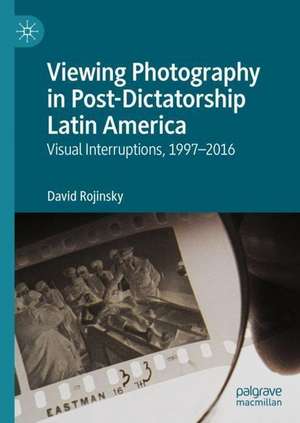Viewing Photography in Post-Dictatorship Latin America: Visual Interruptions, 1997-2016
Autor David Rojinskyen Limba Engleză Hardback – dec 2022
| Toate formatele și edițiile | Preț | Express |
|---|---|---|
| Paperback (1) | 725.13 lei 6-8 săpt. | |
| Springer International Publishing – 2 dec 2023 | 725.13 lei 6-8 săpt. | |
| Hardback (1) | 730.35 lei 6-8 săpt. | |
| Springer International Publishing – dec 2022 | 730.35 lei 6-8 săpt. |
Preț: 730.35 lei
Preț vechi: 890.66 lei
-18% Nou
Puncte Express: 1096
Preț estimativ în valută:
139.76€ • 149.44$ • 116.52£
139.76€ • 149.44$ • 116.52£
Carte tipărită la comandă
Livrare economică 17 aprilie-01 mai
Preluare comenzi: 021 569.72.76
Specificații
ISBN-13: 9783031175893
ISBN-10: 3031175891
Pagini: 293
Ilustrații: XVII, 293 p. 35 illus.
Dimensiuni: 148 x 210 mm
Greutate: 0.52 kg
Ediția:1st ed. 2022
Editura: Springer International Publishing
Colecția Palgrave Macmillan
Locul publicării:Cham, Switzerland
ISBN-10: 3031175891
Pagini: 293
Ilustrații: XVII, 293 p. 35 illus.
Dimensiuni: 148 x 210 mm
Greutate: 0.52 kg
Ediția:1st ed. 2022
Editura: Springer International Publishing
Colecția Palgrave Macmillan
Locul publicării:Cham, Switzerland
Cuprins
Chapter 1: Visual Interruptions.- Chapter 2: Vernacular Presence.- Chapter 3: Imagined Genealogies.- Chapter 4: Memory Walls.- Chapter 5: Absent Gazes.- Chapter 6: Never Again!.- Chapter 7: Disappeared (Epilogue).
Notă biografică
David Rojinsky is a UK-based independent researcher specialising in Latin American and Iberian visual cultures. His articles have appeared in A Contracorriente, Bulletin of Spanish Visual Studies, Journal of Romance Studies and Journal of Iberian and Latin American Studies. He is the author of the monograph, Companion to Empire: A Genealogy of the Written Word in Spain and New Spain, c. 550–1550, published in 2010.
Textul de pe ultima copertă
This book examines the archival aesthetic of mourning and memory developed by Latin American artists and photographers between 1997-2016. Particular attention is paid to how photographs of the assassinated or disappeared political dissident of the 1970s and 1980s, as found in family albums and in official archives, were not only re-imagined as conduits for private mourning, but also became allegories of social trauma and the struggle against socio-political amnesia. Memorials, art installations, photo-essays, street projections, and documentary films are all considered as media for the reframing of these archival images from the era of the Cold War dictatorships in Argentina, Chile, Guatemala, and Uruguay. While the turn of the millennium was supposedly marked by “the end of history” and, with the advent of digital technologies, by “the end of photography,” these works served to interrupt and hence, belie the dominant narrative on both counts. Indeed, the book's overarchingcontention is that the viewer’s affective identification with distant suffering when engaging these artworks is equally interrupted: instead, the viewer is invited to apprehend memorial images as emblems of national and international histories of ideological struggle.
David Rojinsky is a UK-based independent researcher specialising in Latin American and Iberian visual cultures. His articles have appeared in A Contracorriente, Bulletin of Spanish Visual Studies, Journal of Romance Studies and Journal of Iberian and Latin American Studies. He is the author of the monograph, Companion to Empire: A Genealogy of the Written Word in Spain and New Spain, c. 550–1550, published in 2010.
Caracteristici
Offers a rare study in English of memory art photography from several post-dictatorship Latin American countries Links a range of memorial artworks to wider histories of Cold War state terror in the Global South Contributes to debates over the ethical spectatorship of post-conflict images
